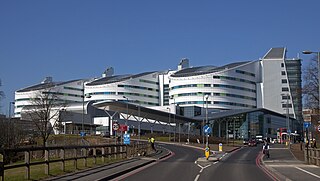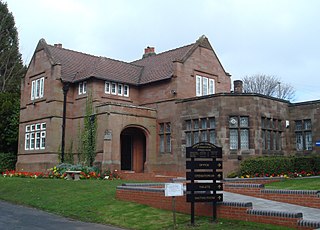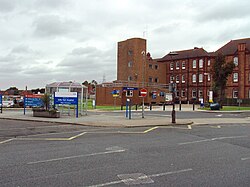
Whittington Hospital is a district general and teaching hospital of UCL Medical School and Middlesex University School of Health and Social Sciences. Located in Upper Holloway, it is managed by Whittington Health NHS Trust, operating as Whittington Health, an integrated care organisation providing hospital and community health services in the north London boroughs of Islington and Haringey. Its Jenner Building, a former smallpox hospital, is a Grade II listed building.

The Royal Oldham Hospital is a NHS hospital in the Coldhurst area of Oldham, Greater Manchester, England. It is managed by the Northern Care Alliance NHS Foundation Trust. The hospital has its own volunteer-run radio station, Radio Cavell, which broadcasts at 1350 AM.

The Queen Elizabeth Hospital Birmingham is a major, 1,215 bed, tertiary NHS and military hospital in the Edgbaston area of Birmingham, situated very close to the University of Birmingham. The hospital, which cost £545 million to construct, opened on 16 June 2010, replacing the previous Queen Elizabeth Hospital and Selly Oak Hospital. It is one of the largest single-site hospitals in the United Kingdom and is part of one of the largest teaching trusts in England.

North Manchester General Hospital (NMGH) is a large NHS hospital in Crumpsall, North Manchester, England. It is operated by Manchester University NHS Foundation Trust. There is an accident and emergency unit, together with a maternity unit, high dependency unit and a mental health wing. A plan to rebuild the hospital was announced by Boris Johnson in the 2019 General Election campaign, and in November 2020 a £54 million funding bid for improvement works was made by the Trust, Manchester City Council, and Manchester Health and Care Commissioning.

City Hospital is a major hospital located in Birmingham, England, operated by the Sandwell and West Birmingham Hospitals NHS Trust. It provides an extensive range of general and specialist hospital services. It is located in the Winson Green area of the west of the city.

Croydon University Hospital, known from 1923 to 2002 as Mayday Hospital and from 2002 to 2010 as Croydon Hospital, is a large NHS hospital in Thornton Heath in south London, England run by Croydon Health Services NHS Trust. It is a District General Hospital with a 24-hour Accident and Emergency department. The hospital is based on a 19-acre (7.7 ha) site in Thornton Heath to the north of central Croydon.

Leicester General Hospital (LGH) is a National Health Service hospital located in the suburb of Evington, about three miles east of Leicester City Centre, and is a part of University Hospitals of Leicester NHS Trust. It has approximately 430 beds. The hospital is the largest employer in the area.

The Northern General Hospital is a large teaching hospital and Major Trauma Centre in Sheffield, England. Its departments include Accident and Emergency for adults, with children being treated at the Sheffield Children's Hospital on Western Bank. The hospital is managed by the Sheffield Teaching Hospitals NHS Foundation Trust.

Lodge Hill Cemetery is a municipal cemetery and crematorium in Selly Oak, Birmingham, England. The cemetery was first opened by King’s Norton Rural District Council in 1895, and during the 1930s became the site of Birmingham's first municipal crematorium.

The Royal Shrewsbury Hospital is a teaching hospital in Shrewsbury, Shropshire, England. It forms the Shrewsbury site of the Shrewsbury and Telford Hospital NHS Trust, serving patients from Shropshire and Powys, in conjunction with the Princess Royal Hospital in Telford.

Newcastle General Hospital (NGH) was for many years the main hospital for the city of Newcastle upon Tyne, England. As part of Newcastle upon Tyne Hospitals NHS Foundation Trust moving from three to two key sites, the hospital was closed and the majority of services transferred to the city's other two hospitals, the Royal Victoria Infirmary and the Freeman Hospital. The Accident and Emergency Department and Intensive Care closed on 16 November 2010. A walk-in centre for minor ailments and injuries remained on the site.

The Royal Blackburn Teaching Hospital is an acute District General Hospital in Blackburn, Lancashire operated by the East Lancashire Hospitals NHS Trust.

University Hospital Lewisham is a teaching hospital run by Lewisham and Greenwich NHS Trust and serving the London Borough of Lewisham. It is now affiliated with King's College London and forms part of the King's Health Partners academic health science centre. It is situated on Lewisham High Street between Lewisham and Catford.

Princess Royal University Hospital or PRUH is a large acute district general hospital situated in Locksbottom, near Farnborough, in the London Borough of Bromley. It is managed by King's College Hospital NHS Foundation Trust.

Christchurch Hospital is run by the University Hospitals Dorset NHS Foundation Trust. It is located in Fairmile in Christchurch, Dorset, England. The hospital was managed by The Royal Bournemouth and Christchurch Hospitals NHS Foundation Trust until the merger with Poole Hospital NHS Foundation Trust on 1 October 2020.

Kingston Hospital is an acute hospital in Kingston upon Thames, England. It is managed by the Kingston Hospital NHS Foundation Trust. It has an Accident & Emergency Unit, a popular midwife-led Maternity unit, and an STD clinic known as the Wolverton Centre.

Solihull Hospital is an acute general hospital in Solihull, West Midlands, England. It is managed by University Hospitals Birmingham NHS Foundation Trust.

Brighton General Hospital is an acute general hospital on Elm Grove in Brighton, East Sussex. It is managed by Sussex Community NHS Trust. The main Arundel building is Grade II listed.

Highgate Hospital was a name used to refer to the infirmary building which opened in 1869 on the St Pancras side of Dartmouth Park Hill in Highgate, London.

The Heavitree Hospital (currently branded as the Royal Devon and Exeter Hospital (Heavitree)) is a hospital currently operated by the Royal Devon University Healthcare NHS Foundation Trust, as a satellite site of the Royal Devon and Exeter Hospital with its main site a short distance away at Wonford. The hospital started as the Exeter Workhouse, and was also known as the Exeter City Hospital.
























